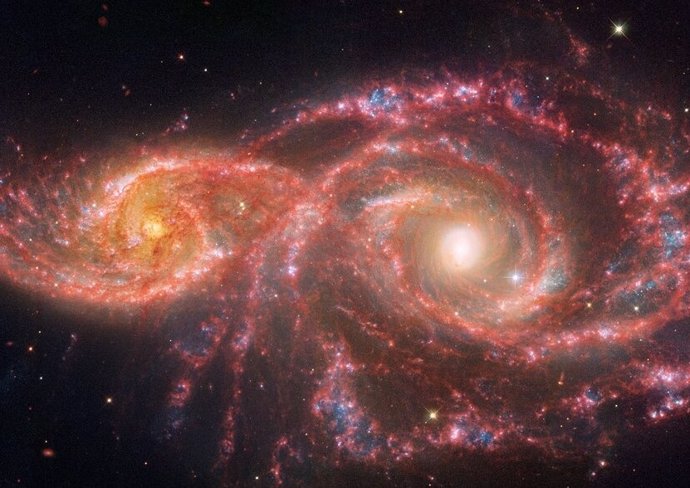Galaxies IC 2163 and NGC 2207 – NASA/ESA/CSA
Oct. 31 () –
Combined data in infrared, visible and ultraviolet light from the Webb and Hubble space telescopes, show in macabre colors two overlapping spiral galaxies seen from Earth.
“It looks like blood is pouring out of the top of a fleshless face. The long, frightful ‘gaze’ of their scorching, eye-like cores shines in the supreme cosmic darkness. These galaxies have only brushed against each other so far: the smaller spiral on the left, cataloged as IC 2163, ‘creeped’ very slowly behind NGC 2207, the spiral galaxy on the right, millions of years ago,” explains the THAT in a statement.
The approach of the galaxies may also have distorted their delicately curved arms, taking out tidal extensions in various places. The tiny, diffuse spiral arms between the core of IC 2163 and its leftmost arm may be an example of this activity. Even more tendrils appear to be hanging between the galaxies’ cores. Another extension ‘scrolls’ from the top of the larger galaxy, forming a thin, semi-transparent arm that practically comes out of the screen.
Both galaxies have high rates of star formation, like countless individual hearts fluttering throughout their arms. Each year, galaxies produce the equivalent of two dozen new Sun-sized stars. Our Milky Way galaxy only forms the equivalent of two or three new Sun-sized stars per year. Both galaxies have also hosted seven known supernovae in recent decades, a high number compared to the average of one every 50 years in the Milky Way. Each supernova may have cleared space in the arms of galaxies, rearranging the gas and dust which then cooled and allowed many new stars to form.
The “action sequences” Star formation manifests itself in bright blue areas captured by Hubble in ultraviolet light and pink and white regions detailed primarily by Webb’s mid-infrared data. The largest areas of stars are known as superstar clusters, which are seen in the upper spiral arm that wraps around the largest galaxy and points to the left.
Other bright regions in galaxies are mini starbursts, places where many stars form in rapid succession. Additionally, the upper and lower “eyelids” of IC 2163, the smaller galaxy on the left, It is full of more recent star formation and shines brightly.











![[Img #74674]](https://thelatestnews.world/wp-content/uploads/2024/12/Santiago-Ramon-y-Cajal-The-promoter-of-modern-neuroscience-300x200.jpg)
Add Comment